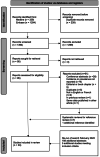Prevalence and Incidence of Huntington's Disease: An Updated Systematic Review and Meta-Analysis
- PMID: 36161673
- PMCID: PMC10086981
- DOI: 10.1002/mds.29228
Prevalence and Incidence of Huntington's Disease: An Updated Systematic Review and Meta-Analysis
Abstract
The incidence and prevalence of Huntington's disease (HD) based on a systematic review and meta-analysis of 20 studies published from 1985 to 2010 was estimated at 0.38 per 100,000 person-years (95% confidence interval [CI], 0.16-0.94) and 2.71 per 100,000 persons (95% CI, 1.55-4.72), respectively. Since 2010, there have been many new epidemiological studies of HD. We sought to update the global estimates of HD incidence and prevalence using data published up to February 2022 and perform additional analyses based on study continent. Medline and Embase were searched for epidemiological studies of HD published between 2010 and 2022. Risk of bias was assessed using a quality assessment tool. Estimated pooled prevalence or incidence was calculated using a random-effects meta-analysis. A total of 33 studies published between 2010 and 2022 were included. Pooled incidence was 0.48 cases per 100,000 person-years (95% CI, 0.33-0.63). Subgroup analysis by continent demonstrated a significantly higher incidence of HD in Europe and North America than in Asia. Pooled prevalence was 4.88 per 100,000 (95% CI, 3.38-7.06). Subanalyses by continent demonstrated that the prevalence of HD was significantly higher in Europe and North America than in Africa. The minor increase in prevalence (more so than incidence) demonstrated in this updated review could relate to the enhanced availability of molecular testing, earlier diagnosis, increased life expectancy, and de novo mutations. Limitations include variable case ascertainment methods and lacking case validation data. © 2022 Her Majesty the Queen in Right of Canada. Movement Disorders published by Wiley Periodicals LLC on behalf of International Parkinson and Movement Disorder Society. Reproduced with the permission of the Minister of Public Health Agency of Canada.
Keywords: Huntington's disease; incidence studies; prevalence studies.
© 2022 Her Majesty the Queen in Right of Canada. Movement Disorders published by Wiley Periodicals LLC on behalf of International Parkinson and Movement Disorder Society. Reproduced with the permission of the Minister of Public Health Agency of Canada.
Figures
Comment in
-
Reply to Letter to the Editor: Prevalence and Incidence of Huntington's Disease Comment on Medina et al. (2022).Mov Disord. 2023 Aug;38(8):1572-1573. doi: 10.1002/mds.29528. Mov Disord. 2023. PMID: 37565396 No abstract available.
-
Prevalence and Incidence of Huntington's Disease.Mov Disord. 2023 Aug;38(8):1570-1572. doi: 10.1002/mds.29532. Mov Disord. 2023. PMID: 37565397 No abstract available.
Similar articles
-
The incidence and prevalence of Huntington's disease: a systematic review and meta-analysis.Mov Disord. 2012 Aug;27(9):1083-91. doi: 10.1002/mds.25075. Epub 2012 Jun 12. Mov Disord. 2012. PMID: 22692795 Review.
-
Incidence of adult Huntington's disease in the UK: a UK-based primary care study and a systematic review.BMJ Open. 2016 Feb 23;6(2):e009070. doi: 10.1136/bmjopen-2015-009070. BMJ Open. 2016. PMID: 26908513 Free PMC article. Review.
-
Folic acid supplementation and malaria susceptibility and severity among people taking antifolate antimalarial drugs in endemic areas.Cochrane Database Syst Rev. 2022 Feb 1;2(2022):CD014217. doi: 10.1002/14651858.CD014217. Cochrane Database Syst Rev. 2022. PMID: 36321557 Free PMC article.
-
The global prevalence of Huntington's disease: a systematic review and discussion.Neurodegener Dis Manag. 2016 Aug;6(4):331-43. doi: 10.2217/nmt-2016-0008. Epub 2016 Jul 20. Neurodegener Dis Manag. 2016. PMID: 27507223 Review.
-
Global incidence and prevalence of bullous pemphigoid: A systematic review and meta-analysis.J Cosmet Dermatol. 2022 Oct;21(10):4818-4835. doi: 10.1111/jocd.14797. Epub 2022 Feb 1. J Cosmet Dermatol. 2022. PMID: 35080093
Cited by
-
Can exercise benefits be harnessed with drugs? A new way to combat neurodegenerative diseases by boosting neurogenesis.Transl Neurodegener. 2024 Jul 25;13(1):36. doi: 10.1186/s40035-024-00428-7. Transl Neurodegener. 2024. PMID: 39049102 Free PMC article. Review.
-
Risk Factors and Interventions for Suicide in Huntington's Disease-A Systematic Review.J Clin Med. 2024 Jun 12;13(12):3437. doi: 10.3390/jcm13123437. J Clin Med. 2024. PMID: 38929966 Free PMC article. Review.
-
Sex contribution to average age at onset of Huntington's disease depends on the number of (CAG)n repeats.Sci Rep. 2024 Jul 8;14(1):15729. doi: 10.1038/s41598-024-64105-5. Sci Rep. 2024. PMID: 38977715 Free PMC article.
-
The flavonoid luteolin reduces mutant huntingtin aggregation and cytotoxicity in huntingtin-mutated neuroblastoma cells.Saudi Pharm J. 2023 Dec;31(12):101871. doi: 10.1016/j.jsps.2023.101871. Epub 2023 Nov 21. Saudi Pharm J. 2023. PMID: 38125952 Free PMC article.
-
Cross Talks between CNS and CVS Diseases: An Alliance to Annihilate.Curr Cardiol Rev. 2024;20(3):63-76. doi: 10.2174/011573403X278550240221112636. Curr Cardiol Rev. 2024. PMID: 38441007 Free PMC article. Review.
References
-
- Caron NS, Wright GEB, Hayden MR. Huntington disease. In: Adam MP, Ardinger HH, Pagon RA, et al., eds. GeneReviews. Seattle, WA: University of Washington, Seattle Copyright © 1993–2022, University of Washington, Seattle. GeneReviews is a registered trademark of the University of Washington, Seattle. All rights reserved; 1993.
-
- Duyao M, Ambrose C, Myers R, et al. Trinucleotide repeat length instability and age of onset in Huntington's disease. Nat Genet 1993;4:387–392. - PubMed
-
- Pringsheim T, Wiltshire K, Day L, Dykeman J, Steeves T, Jette N. The incidence and prevalence of Huntington's disease: a systematic review and meta‐analysis. Mov Disord 2012;27:1083–1091. - PubMed
Publication types
MeSH terms
LinkOut - more resources
Full Text Sources
Medical


